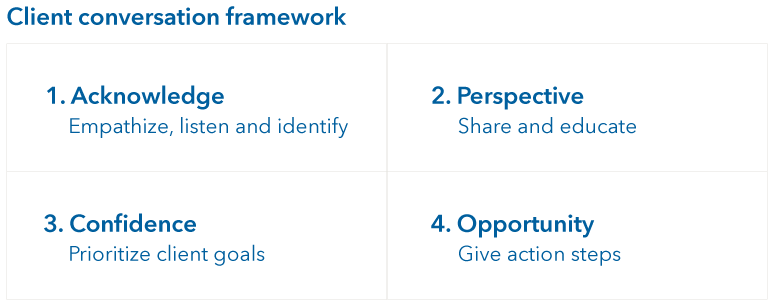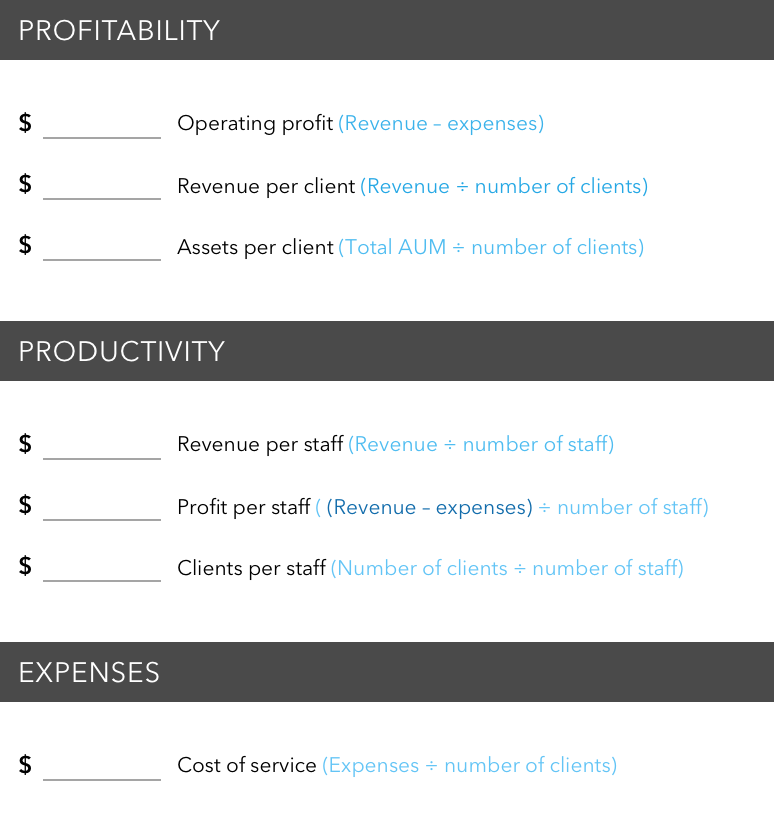Marketing & Client Acquisition
6 MIN ARTICLE
For advisor use only. Not for use with investors.
Have you ever wondered how some top-performing financial advisors are able to build their practices year after year and in all types of markets? Many advisors understand that deep engagement with clients is key to long-term loyalty, quality referrals and practice growth. But how to get there isn’t always so obvious.
“Through years of experience working with thousands of advisors, we’ve seen that the most successful practices take a deliberate, holistic approach to serving the increasingly complex needs of investors,” says Shaun Tucker, director of Advisor Practice Management. “To help advisors achieve the growth they are seeking, we help them prioritize client management and business management alongside investment management.”
1. Turbocharge your brand
Tucker and his team of advisor practice management consultants have developed a comprehensive, personalized practice management program to help more financial advisors benefit from the strategies and best practices they’ve seen lead to results. Known as Elite Engagement, it is designed around a set of capabilities that can help improve client engagement, increase acquisition and referrals, and boost practice growth:
Stand out by creating a brand that connects with clients’ emotions and memorably demonstrates the value you offer
Having a defined, differentiated and well-demonstrated brand is an essential aspect of doing business today. Being able to clearly articulate what you do, and how that makes you different from other financial professionals, can not only help you gain more meaningful referrals, but it can also help you deepen engagement with your existing book of business.
2. Acquire the ideal client
When you realize your brand goes well beyond a logo and marketing materials — and that it has implications for everything you do, from the way you present your practice online, how you conduct meetings and the environment you create in your office — you can unlock new opportunities to stand out with clients and prospects.
Have a clear picture of the clients you are best set up to serve — how your skills and capabilities match their needs, and how to allocate effort to address those needs
Knowing exactly the kinds of clients you want to attract to your practice is the first step to having a smart, effective acquisition strategy. Once you define your ideal client, you can tailor your services and your marketing to appeal specifically to your target. But how to get started?

3. Deliver results, not performance
One important way is by taking an intentional approach to examining how specific client needs, wants and concerns align with your competencies. This can lead to several important strategic steps, such as segmenting your book (to ensure you’re spending the right amount of time with the right clients) and deriving more value from client relationships by looking beyond revenue calculations to determine real relationship value (RRV).
Shape clients’ expectations based on how you’re helping them get closer to their personal goals — not based on market ups and downs
It’s easy for clients to become fixated on what the market’s doing and to evaluate you based on performance expectations. But a client’s truest success measure isn’t relative performance; it’s the progress they are making toward their most important goals.
4. Deliver priceless value
So, how do you help clients prioritize those goals and reframe their perception of success? It starts with placing progress toward goals at the centre of every client interaction, from your onboarding process and marketing, to how you conduct ongoing conversations and quarterly reviews. Focusing on effective storytelling is one way to reframe how clients think about success — and how they think about risk.
Focus on high-quality client experiences that exceed expectations and are priced to reflect your value
In an industry where there is still so much focus on relative performance, some of the highest value services advisors provide go unrecognized or taken for granted. Frequently, investors don’t consider the value they’re receiving.

5. Drive productivity and efficiency
Yet top advisors know how to showcase their value in ways that make it easier for clients to recognize what their services are truly worth. One important way to start? Have better conversations with clients, using words and actions that trigger the “trust hormone” oxytocin, and always ending with opportunities to recommend. Our Client Conversation Framework — with its emphasis on empathetic listening and perspective sharing — can be a useful tool for supporting successful client meetings.
Run your practice more like a business

To create meaningful long-term growth for your practice, it’s important to keep a watchful eye on how you and your team allocate your precious, finite resources. Thinking like a CEO means applying key performance indicators to track profitability, productivity and expenses — so you always know how you’re doing and where you can improve.
6. Fuel growth with a COI engagement strategy
Of course, your primary aim is to create capacity, freeing up more of your time to focus on activities where you can add the most value, while strategically delegating the rest. When you’re ready to optimize your business, find proven methods to help determine whether you’re spending the right amount of time with the clients who represent the highest value to your business.
Use social currency to grow your client base and establish new referral streams
Centres of influence (COIs) are other professionals who serve your clients, and building relationships with them can be a powerful source of referrals and business growth. Yet the potential that COI relationships hold for business growth is often overlooked by advisors. How can you shift your thinking? Start seeking ways to build social currency with people you want to work with and reach.
7. Prospect and grow in a digital world
For instance, are you looking to join a new network of influencers? Connect with professionals with whom you can reciprocally refer clients? Build mutually beneficial arrangements where a shared client is at the center of your COI relationships? Once you narrow your approach, focus on tactics that help you connect with clients and other professionals online — or use your ideal client profile to focus in on target audiences.
Boost your digital skills to find and serve clients effectively online
Digital engagement is here to stay, and there’s a good chance you are already using technology to reach clients. But are you doing all you can to enhance your digital brand and create even stronger connections with clients and prospects? How can you up your game?
Start by asking: Is my digital presence as potent and effective as in-person interactions? Are virtual events and meetings rewarding and engaging for participants? Does my team’s social media presence adequately humanize our practice and reinforce the ways we want to be seen by clients and prospects?
8. Attract modern retirees
Burnishing your digital brand is essential to building trust, offering more opportunities for people to get to know who you are and the value you offer.
Adapt your service offerings to meet the changing expectations and needs of today’s modern retirees
Today’s retirees are more likely to view the experience as a dynamic opportunity for personal growth and reinvention. Being able to offer perspective on how they might get the most out of their post-working years can be an essential part of your role as an advisor.
.png)
This shift has significant implications for many aspects of your retirement planning conversations: from helping clients create a solid retirement income strategy, to understanding how their CPP pension fits into their overall plan and having in-depth discussions about how (and with whom) clients want to spend their days once they stop working full time.
9. Future-proof your practice
Sharpening your skills and focusing your practice around these rapidly shifting needs can help you gain more clients and deepen relationships with existing ones.
Incorporate a modern acquisition strategy that considers relatability, resilience and sustainability
The thriving practices of tomorrow will be those that can adapt and expand into new potential client bases and serve previously untapped markets. A modern approach to acquisition may incorporate communications, marketing, service offerings and succession planning.
As a first step, it helps to understand the potential power of underserved audiences within your community, including millennials, members of Generation Z, women and people of colour. It also helps to examine your team and find ways to fill gaps in capabilities in a way that helps employees stay satisfied and engaged.
What sets Elite Engagement apart, Tucker says, are the tools and resources his team uses to bring each idea to life. “From learning creative ways to market yourself, to addressing practical needs like succession planning, most advisors have some room to enhance their skills or grow their practice,” he says. “Our focus on implementation and accountability is what makes Elite Engagement so effective.”
Related content
-
Client Relationship & Service
-
Client Conversations

